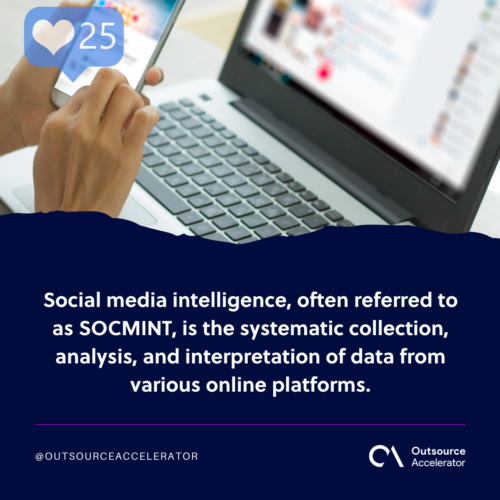Going beyond likes and shares: Demystifying social media intelligence

Social media has woven itself intricately into the fabric of our daily lives. Currently, billions of people are actively sharing their thoughts, opinions, and experiences online.
In the vast sea of social media data lies a goldmine of valuable insights for businesses. This is why organizations are taking advantage of social media intelligence.
Sprout Social revealed that 60% of businesses are using social media data every week. 65% of companies use it as a sales strategy, and 48% for product development.
In this article, we’ll explore how to leverage social media intelligence to make data-driven decisions that contribute to the betterment of a business.
What is social media intelligence?
Social media intelligence, often referred to as SOCMINT, is the systematic collection, analysis, and interpretation of data from various online platforms.
This approach aims to get valuable insights that can be used to make actionable blueprints for business improvement.
Findings from SOCMINT are crucial for businesses, organizations, and even governments to:
- Make informed decisions
- Develop effective strategies
- Better understand their target audiences
Social media intelligence goes beyond simply monitoring likes and shares. It dives deeper into understanding consumer sentiment, market trends, brand reputation, and competitive analysis.

Elements of social media intelligence
Social medial intelligence is made up of several key components, including:
Monitoring of social media platforms
SOCMINT starts with monitoring social media platforms like Facebook, X, Instagram, and LinkedIn.
It involves keeping a constant watch over conversations, mentions, hashtags, comments, and shares related to the brand or industry of interest.
Intelligence collection
Once the monitoring phase begins, the next step is to collect relevant data from social media platforms. This includes capturing and storing data, like posts, comments, user profiles, and engagement metrics.
Advanced tools and software are used to streamline this process and capture data in real time.
Data analysis
After collecting the necessary data, the next step is to analyze it to uncover meaningful insights.
Natural language processing (NLP) techniques and sentiment analysis are used to understand the tone, emotions, and sentiments expressed in social media conversations.
This analysis helps identify trends, user preferences, influencers, and potential opportunities or threats.
Generation of actionable insights
The ultimate goal of social media intelligence is to generate actionable insights. These insights inform strategic decision-making, such as:
- Refining marketing campaigns
- Improving products or services
- Identifying customer pain points
- Improving customer experience
- Staying ahead of the competition
SOCMINT as a subset of OSINT
Social media intelligence is also a subset of open source intelligence (OSINT). OSINT is collecting and analyzing publicly available information to gain insights and intelligence.
Social media plays a significant role in OSINT, providing a vast amount of real-time, user-generated data that was not readily accessible in the pre-social media era.
Social media intelligence vs. Social media monitoring vs. Social listening
SOCMINT is often confused with two related terms: social media monitoring and social listening. While they are interconnected, they serve distinct purposes.
Social media monitoring focuses on tracking online conversations and mentions related to a brand, industry, or topic. It involves keeping a pulse on what people say and how they engage with the brand online.
Social listening takes social media monitoring a step further by actively analyzing and understanding the sentiment, context, and emotions behind the conversations.
It aims to gather valuable insights about consumer preferences, trends, and industry shifts.
Social media intelligence encompasses both monitoring and listening but goes beyond.
As established, this process employs advanced data analysis techniques to extract actionable insights. It is a more comprehensive approach that focuses on strategic decision-making.
Is social media intelligence unlawful?
It’s important to address the question of legality when it comes to social media intelligence.
As with any form of data collection, there are ethical considerations to take into account. It’s important to respect privacy and comply with data protection laws.
It’s already a given that unauthorized access to private or sensitive information is unlawful and unethical.
Social media intelligence is perfectly legal and ethical as long as the data collected is publicly available and no privacy or legal boundaries are crossed.
SOCMINT does not involve hacking, spying, or accessing private or personal information. It relies solely on publicly shared content and conversations.
However, it is crucial to adhere to the terms and conditions set by social media platforms and respect user privacy.
Responsible social media intelligence practitioners ensure that they adhere to legal and ethical guidelines while conducting their research.

How social media intelligence helps businesses
Social media intelligence provides many benefits for businesses to stay competitive and relevant.
Understanding customer sentiment and preferences
SOCMINT provides businesses with valuable insights into customer sentiment, opinions, and preferences.
By analyzing online conversations, companies can gain an understanding of what their customers like, dislike, and expect from their products or services.
This insight serves as a guide in:
- Refining marketing strategies
- Improving offerings
- Enhancing customer experience
Brand reputation management
In this era of digitalization, managing brand reputation is more critical than ever.
Social media intelligence allows businesses to monitor and address any negative mentions, complaints, or issues related to their brand.
By quickly identifying and resolving these issues, companies can protect their reputation and maintain customer trust.
Competitor analysis
SOCMINT plays a crucial role in competitive analysis by keeping businesses informed about their competitors‘ activities, strategies, and customer sentiment.
By monitoring competitor social media channels, companies can:
- Identify opportunities
- Measure their competitive positioning
- Develop or adjust strategies to stay ahead
Crisis management
In times of crisis, social media intelligence can be invaluable. It helps businesses monitor and respond swiftly to:
- Any negative sentiment
- Rumors
- Potential PR disasters related to their brand
By addressing these issues promptly and effectively, companies can mitigate any damage to their reputation and maintain customer trust.
Influencer identification and partnerships
Social media influencers have become powerful marketing tools. SOCMINT helps businesses find relevant influencers in their industry and analyze their reach, engagement, and authenticity.
By building partnerships with influencers, enterprises can:
- Extend their brand reach
- Tap into new audience segments
- Drive customer engagement
Identifying trends
The real-time nature of social media makes it a goldmine for identifying emerging trends. Businesses can tap into these trends to tailor their offerings and marketing efforts accordingly.
Other applications of social media intelligence
Apart from the advantages mentioned above, social media intelligence has several other applications in business:
- Product development. By monitoring online conversations and analyzing customer feedback, businesses can gather insights to improve existing products or develop new ones that align with customer needs and preferences.
- Market research. SOCMINT provides a cost-effective way to conduct market research. It helps brands understand market trends, emerging customer needs, and competitive landscapes without investing heavily in traditional research methods.
- Content creation. Analyzing social media conversations helps companies understand what content resonates with their target audience. Engagement metrics and feedback can fine-tune strategies to produce more engaging and shareable content.
- Sales and lead generation. Social media intelligence helps businesses identify potential customers, track their behaviors, and understand their preferences. Leveraging these insights optimizes sales and lead generation strategies, leading to increased conversions and revenue.
- Brand positioning. SOCMINT helps understand how a brand is perceived in the market. Companies can refine their messaging, positioning, and branding strategies by analyzing conversations, sentiment, and engagement to align with customer expectations.

Social media intelligence also extends beyond the business realm and finds relevance in other sectors:
- Government and law enforcement. SOCMINT is used by law enforcement agencies to gather information related to criminal activities, track potential threats, and anticipate public unrest.
- Healthcare. Healthcare organizations use social media intelligence to track public health trends, gather patient feedback, and monitor the spread of diseases.
- Politics. Political campaigns utilize SOCMINT to gauge public sentiment, understand voter concerns, and tailor their messaging accordingly.
How to properly use social media intelligence
To make the most of social media intelligence, it is important to follow these best practices:
- Set clear objectives. Clearly define your goals and what you want to achieve from your social media intelligence efforts. This will help guide your monitoring, analysis, and decision-making processes.
- Choose the right tools. Utilize social media monitoring and analytics tools that align with your objectives and provide the necessary features. This could involve sentiment analysis, competitor tracking, and data visualization.
- Identify relevant metrics. Determine the key metrics that align with your objectives and track them consistently. This could include sentiment analysis, engagement rates, conversation volume, and share of voice.
- Understand context. Interpretation is key to avoiding the misunderstanding of data. Consider factors like cultural nuances, sarcasm, and irony to get a more accurate understanding of sentiment and meaning.
- Integrate with other data sources. SOCMINT should not be analyzed in isolation. Integrating it with other data sources, like customer feedback, sales data, and market research, provides a holistic view and enhances decision-making.
- Develop actionable insights. The ultimate aim of social media intelligence is to drive action. Ensure that the insights you gather lead to informed decisions and tangible outcomes.
- Keep up with the evolving landscape. Social media platforms, trends, and user behaviors are constantly changing. Stay updated with the latest developments to ensure your SOCMINT stays relevant and effective.







 Independent
Independent




